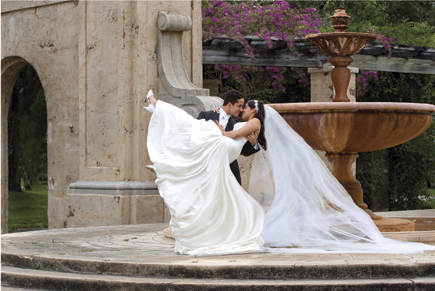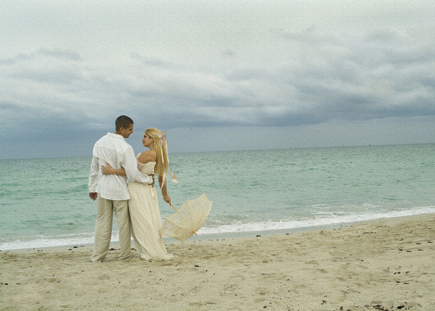Wedding Photography; Two “Camps” Of Style And Vision Page 2
Lino does credit photojournalists for educating consumers about the kinds of images they should have. “Many years ago,” Lino says, “the average bride would not buy a picture where she was not facing the camera smiling. But photojournalists promoted the idea that they needed photographs of the cake, flowers, and shoes, because they’d spent a lot of time and money on the details. In the past wedding photographers thought they had to be either extremely journalistic or extremely traditional, but now they’re beginning to realize there is a happy medium between the two styles that provides complete coverage of the event.”
Your Style, Your Viewpoint
Though most wedding photographers lean toward either the traditional or journalistic approach, it’s still important to develop a style that sets you apart from the crowd. Unfortunately, many photographers photograph using someone else’s style because they don’t have confidence in their own. Photographer Tony Hewitt (www.tonyhewitt.com) states, “Your viewpoint is something no one else in the world shares.
 |
|
|
“Yet so many people coming into the industry think if they can copy so-and-so’s work to a ‘T,’ then they will be a good photographer. But the best photographers are the ones who break free and have their own vision, which becomes the one others want to copy. A photographer’s role is to show the rest of the world how they see.” Hewitt says photographers need to develop their ability to see what others don’t, and to trust that their perspective is unique. “The challenge as a photographer is to express that unique perspective through skill, technique, and equipment.”
Weddings have a lot of things in common—a ceremony, a first dance, a cake, etc. Weddings may seem repetitive, but they’re really not. These differences are where a photographer can excel. Hewitt says the unique thing about every wedding is the chemistry between the couple, and if you can focus on that chemistry, you will find the source of creativity for that wedding.
 |
|
|
For inspiration, Hewitt looks at the work of colleagues both inside and outside the industry, at his daughter’s Facebook pictures, television, fashion magazines, and art and makeup advertisements. By looking at images from a wide cross section of the marketplace, Hewitt can see how the market changes and evolves. In the end, Hewitt says, when people are looking for a photographer, they will buy the person before they’ll buy the style, technique, reputation, and awards. “I truly believe that. All those things may lead them to you, but the interaction and the way they feel around you will be the major factor behind their decision. Very few brides want to be around someone who makes them feel uncomfortable.”
 |
|
|
Lino also advises photographers, especially newcomers, not to follow trends or to copy other people’s styles—and don’t be too concerned about the competition, as there’s enough work to go around. “Stay focused on your own business and developing your own style because a time will come when people recognize your style and seek you out. It’s also a time when price or location does not become the determining factor in booking you,” Lino concludes. “You’ll know when your style is really working when clients call and ask if you’re available for a certain date before they ask how much you charge.”
- Log in or register to post comments

















































